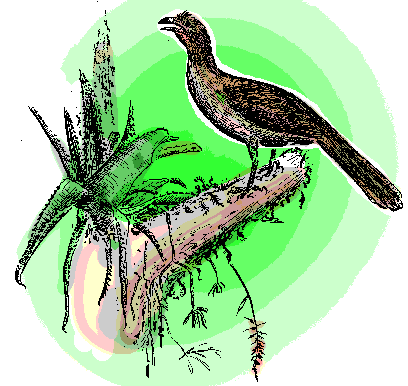Adapted from Jim Conrad's online book A Birding Trip through Mexico, This excerpt from "Hot & Steamy at Témoris Station"
in western Chihuahua state
Jakajakajakajakajaka... !!!
At daybreak the thermometer reads 19.5ºC (67º F). Sunlight kindles the peaks, but here on the canyon floor it remains somber and quiet. Certain hesitant-sounding peeps, quickly smothered outbursts of song, and faint, drawn-out whistles break the hush from time to time, and surely these are voices of interestingly rare and exotic species. However, I can't identify them and can't get a glimpse of what's making them. An hour passes but sunlight makes hardly any progress entering the canyon. The whole canyon remains more than half asleep.
Jakajakajakajakajaka... !!!
Godzilla thrusting his scaly head above the fig tree could not be more shocking than the sudden explosion of this shrill, frenzied call sounding very much like a squealing tire on a gangster's car. There's a beating of wings and then three silhouettes materialize from the fig tree's shadows and in loose formation sail across the canyon. Big birds, these, with long tails and long necks ending in little heads. They look like archaeopteryxes, those half-bird, half-reptile bird-ancestors living 150 million years ago during the late Jurassic period.
The three primeval silhouettes come to rest in another giant fig across the river. Binoculars reveal them to be the northern form of the West Mexican Chachalaca, a mostly brown, slender, turkeylike bird with a wingspread of some eighty-five centimeters (thirty-three inches).

Mexico has three Chachalaca species and all are impressive, but this northern race of the western species is the most handsome of all. Its belly and the tip of its tail are possessed of a rusty red hue that in such a gloomy canyon as this appears to radiate warm light.
When I began birding in Mexico about thirty years ago, I was sure that chachalacas would soon disappear. They were conspicuous birds and men in the countryside often were met carrying guns in the hope of running across them, for chachalacas are favorite hunting fare. However, today in most of the country chachalacas seem as common as ever. Probably that's because they do well in weedy, overgrown areas, such as abandoned cornfields. Also, they are less persnickety than most birds with regard to their food, eating a wide variety of fruit, seeds, leaves, and insects.
What a pleasure to watch these birds walking along the big fig's massive horizontal branches, breathing through their open beaks, and their heads atop those long necks pumping like a chicken's when it walks. There's something ungainly about chachalacas, something in the character of a lanky, loose-jointed teenage boy with big feet and a gigantic Adam's apple. Watching chachalacas, you just like them.